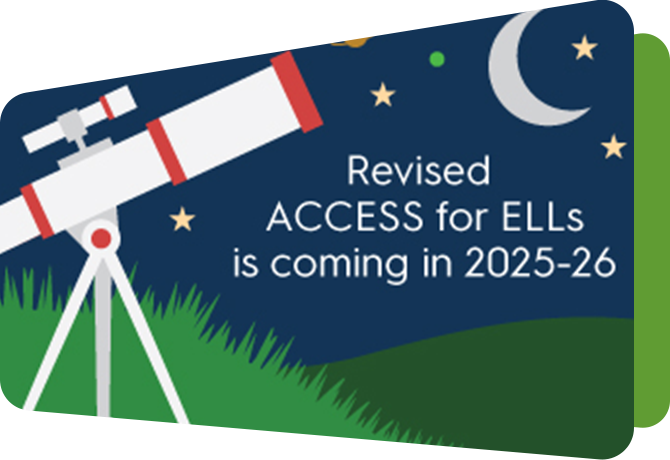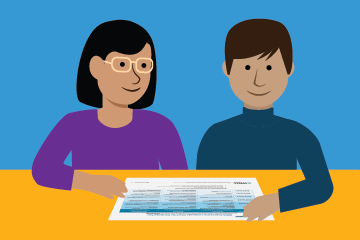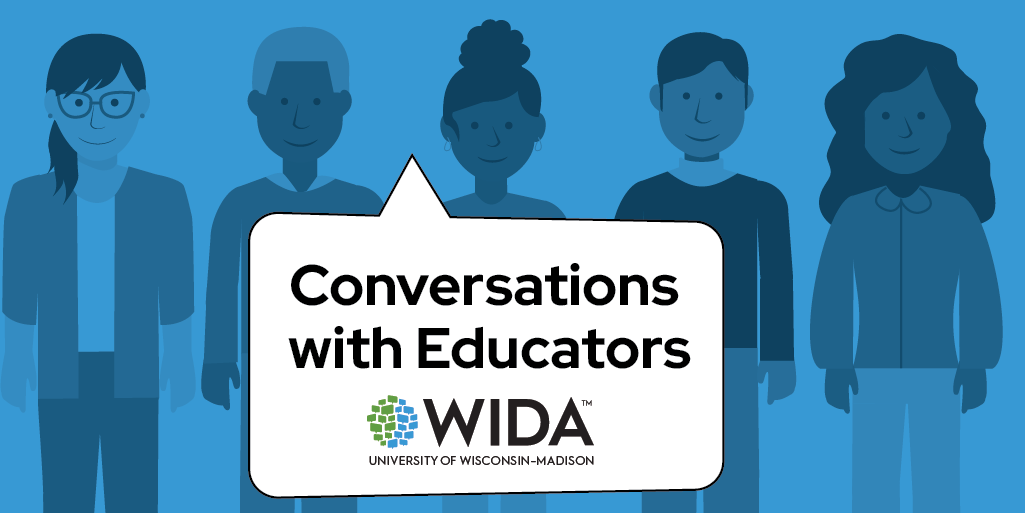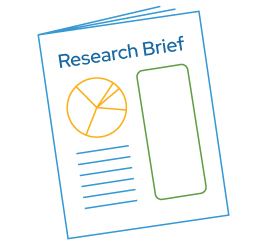Leslie Huff and Laurene L. Christensen
September 2018
Why Communication and Language?
Two foundational components of education are language and communication. Without communication, learning cannot happen. However, among English learners with significant cognitive disabilities, communication may look different. Language may also manifest somewhat differently in this population, but its structure and consistent shared meaning allow for more complex thoughts and learning. Therefore educators must have a deep understanding of communication and language, and of how students in this population use both. When seeking to identify how English learners with significant cognitive disabilities learn language and communicate, educators must clearly distinguish between language and communication.
Defining Communication
Communication is a core function of human existence. As social beings, humans seek to communicate with each other, using a variety of tools from the time they are born. These tools include sounds, gestures, expressions, symbols, and words, among others. Communication is a social event that requires sending and receiving messages with shared understanding of meaning. The tools available for communication expand as a person grows and learns (Gooden & Kearns, 2013). For example, babies can use tools, such as crying, body movements, smiling, and grunting; as they develop and are exposed to more interactions, knowledge, and experiences, they can learn new ways to communicate with facial expressions, written/oral/sign language, dance, music, and other tools.
Communication is a social event that requires sending and receiving messages with shared understanding of meaning.
Communication depends on the production or expression of a message and its reception. That is, a shared understanding of meaning is essential to effective and meaningful communication. This shared meaning must be developed through social interaction, or among participants. Just as a new parent grows to learn the meaning of different cries from an infant, meaning expressed through other aspects of communication including language, the arts, and expression, must be learned or discovered, and shared to be useful.
Defining Language
Language is “a complex and dynamic system of conventional symbols that is used in various modes for thought and communication” (American Speech-Language-Hearing Association, 1982). Learning and using language is a complex process that requires knowledge beyond the words themselves to be used effectively. The American Speech-Language-Hearing Association describes contemporary views of human language as evolving within specific contexts, being governed by phonological, morphologic, syntactic, semantic, and pragmatic rules. Language is learned and used through interaction of biological, cognitive, psychosocial, biological, and environmental factors, and its effective use requires a broad understanding of associated factors such as nonverbal cues, motivation, and sociocultural roles.
Language is a structured and shared form of communication like spoken and written words, figures, characters, and gestures, or a combination of these.
Language is a structured and shared form of communication like spoken and written words, figures, characters, and gestures, or a combination of these. Language includes rules that dictate word order, tense, social use, and these apply differently depending on the culture in which the language is used. As with other forms of communication, language depends on shared meaning and an increasingly complex understanding of the associated rules and structures. As language is learned, receptive language skills, listening and reading) are almost always stronger and more developed than productive counterpart skills (speaking and writing). Accordingly, language learners with and without disabilities often understand more than they can verbally respond to with accuracy.
Communication and Language in Schools
Considering the fundamental role of communication within society, the development of a student’s communication system is an essential undertaking of schools (Kleinert, Kleinert, & Kearns, 2016), especially for students who do not have an effective means of communication when they enter school. The importance of language development cannot be understated and must be addressed holistically, incorporating all four domains (reading, writing, listening, and speaking) for all students learning English, including those with significant cognitive disabilities. These students (including those with significant cognitive disabilities) require a communication system and language foundation that allow for increasingly complex thoughts and ideas to arise and be expressed.
With a command of only basic communication tools such as crying and laughing, a child has the ability to communicate reactions to experiences. A child can get excited and smile when arriving at school, cry to express displeasure, or laugh at something that is observed. At this stage, adults must engage in a significant amount of guessing to establish common understanding. As children increase their grasp of additional communication tools and basic language skills, communication is clearer and opportunity expands for educators to incorporate more complex ideas and concepts into the student’s school experiences. Students may identify their likes more directly by pointing at a picture, for example. They can also express their dislikes by moving papers away from themselves during a task. As language grows, students can express their thinking using traditional forms of speaking and writing, or with augmentative/alternative communication (AAC) devices designed to meet their language needs. Such devices may include word books, iPads, or eye gaze-operated systems. The size of a child’s world correlates directly to their ability to use language: as they expand their skills, they expand their world. Their experiences, thoughts, opinions, and passions are all more easily accessible and available for sharing as their knowledge of complex language grows.
Similar to the English learner population at large, peer interaction is a critical element in the development of communication and language skills for English learners with significant cognitive disabilities. Students need peers who can model communication systems and strategies. Students also need peers, both native English speakers and English learners who can model English. Peer interaction also typically provides foundational motivation for students as they are developing their communication and language skills.
Peer interaction is a critical element in the development of communication and language skills for English learners with significant cognitive disabilities. For English learners with significant cognitive disabilities, interactions with peers is critical to development of both communication and language skills. Students need peers who can model communication systems. Students also need peers, both native speakers and other language learners, who can model English. Interaction is the key!
Language acquisition follows a typical order regardless of language. Learners of language, however, do not move lockstep in language development; individuals learn at various speeds and use a variety of methodologies, strategies, and tools, but all individuals can learn to use language. At the same time, language may not take the same form across students, especially among English learners with significant cognitive disabilities. In this population, students are often aided in their expressive communication in language by tools such as using eye gaze in response to a question (demonstrating listening comprehension) or in selecting words to compose a sentence (writing). Nonverbal students may use assistive technologies like a speech generating device or text-to-talk applications, whereas others may benefit from audiobooks to assist with comprehending written text. While these may not be traditional methods of communication, research shows they help students develop and use more complex language over time, aiding in their independence, academic development, and social engagement. Regardless of the communication and language tools employed by a student, those people with whom the student interacts must know what to expect from the student and how to respond.
Combining expertise from the field of second language acquisition with best practices in developing communication systems and teaching students with significant cognitive disabilities will provide the best starting point for addressing all the communications and language needs of students in this target population. Professional development across these areas will provide a solid foundation for professionals serving language learners with significant cognitive disabilities. Shirking the responsibility to address the language needs of English learners with significant cognitive disabilities in addition to their basic communication needs can significantly limit students’ abilities to develop essential skills to be workplace ready and participate in post-secondary and community activities independently or with support.
The focus of schools must include communication, language, and academic growth for all students including those in this target population. English learners with significant cognitive disabilities who need communication intervention require intervention in both languages—the one they hear at home and the one they are learning at school. What they understand in their home language may far exceed what they understand in their new language. Knowing what students are capable of in their home language may be helpful to educators in supporting the student’s language and communication needs at school.
Misconceptions
Several misconceptions exist about English learners with significant cognitive disabilities and their communication and language learning abilities, strategies, and needs.
The first misconception is that English learners with significant cognitive disabilities are limited by their disabilities to only basic communication and language development. This widespread misconception is detrimental to students because it can lead to lowered expectations and inhibited opportunities for growth. While some experts believe this population is incapable of developing complex language, research shows otherwise. Erickson and Geist’s (2016) review of research on the characteristics of students with significant cognitive disabilities indicates that approximately half of these students use abstract language and 70 to 82 percent use symbolic language. Kearns et al. (2015) corroborate these data. All individuals and their behaviors (including gestures, cries, noises) communicate some kind of message. While some English learners with significant cognitive disabilities may enter school with only simple expressive communication tools under their command, when provided the proper support, they can develop complex expressive language skills and learn to use communication systems that support their independence. English learners with significant cognitive disabilities who need communication intervention require intervention in more than one language, the language(s) used at home and in their community, and the language used at school. Their communication in their home language may far exceed what they can do in their new language.
Another common misconception is that students in this population are not prone to growth in language acquisition or academics. Data from Nash, Clark, and Karvonen (2015) show that the highest proportions of students who performed consistently on language tasks were at the high school level followed by students at the middle and then elementary level. These finding indicate these students do indeed respond to effective instruction and demonstrate growth similar to their non-disabled peers.
Misconceptions are found in efforts to erase the uniqueness of these dually qualified students. Statements such as “All of my students are English learners” negate the distinct needs of English learners with significant cognitive disabilities. These students often have significant exposure to more than one language during the course of their daily lives. This exposure and the demands of operating in different languages for different contexts creates needs that are unique to English learners, with or without disabilities. These needs are present even if a student’s language acquisition is only in the early stages of development in any language. The assumption that these students are not significantly different from non-English learners with significant cognitive disabilities can lead to an omission of essential instruction and learning that would greatly add to the student’s learning and lived experiences were they received regularly.
Another commonly shared misconception is that students who do not respond do not understand. Understanding that receptive language skills, listening and reading, usually develop before expressive language skills (speaking and writing) helps people remember that students who do not respond to language still understand. Students understand more than they can express. As they engaged in more language exchanges and receive more structured language instruction, they develop the ability to express themselves and the skills to respond. This is especially true if students must communicate in two languages and also communicate with pictures/symbols.
Resources for Educators
In addition to the references cited for this brief, the following websites may be useful in developing approaches to language instruction as well as establishing an understanding of the importance of language for students with significant cognitive disabilities.
The most important misconception to dispel, though, is the idea that because these students have significant cognitive disabilities, they do not benefit from English language services. This misconception means many students in this population do not receive language development services because school personnel feel that needs generated as a result of their disabilities outweigh their need for language development, or because school personnel feel that limited resources are better utilized with other students. However, English learners with significant cognitive disabilities do benefit from language services. As with other English learner populations, leaving the development of language to educators without that expertise limits the ability of these students to acquire language, especially academic language. While special education teachers or speech language pathologists are well trained in helping students develop systems for communication, specialists in English language development contribute needed expertise in the education of English learners with significant cognitive disabilities as they can help students develop the tools and sequence, and provide explicit instruction to develop language skills.
Considerations
The consequences of not addressing the language and communication needs of English learners with significant cognitive disabilities while they are in school limits their options upon leaving school has repercussions across all areas of the student’s life. As more light is shined on language learners with significant cognitive disabilities, more emphasis must be placed on what these students can do.
More resources must also be applied to facilitating their social and academic progress and maximizing their potential through communication and language development in all of the languages the student must use. These resources will need to include professional time for teachers/therapists with diverse specialties to collaborate and learn from one another in support of students’ growth. Collaboration could include acquiring broader knowledge around the high-tech, mid-tech, and low-tech communication supports and tools available to students with significant cognitive disabilities, as well as how these tools can be used in various settings to support students as they grow. Identifying appropriate tool to support specific students may also be an area of focus for educator collaboration.
Resources should also include an array of augmentative and assistive communication (AAC) options, both high and low tech, as one device will not address the spectrum of communication needs among students. At times AAC devices should be treated as a student’s voice in the classroom, not as toys or distractions only to be used during free time. Further, to implement a comprehensive communication program for English learners there should be designated resources for meeting the needs of students, teachers, and therapists who may need to be involved. In addition, peer modeling and interaction using AAC is essential, not only to help students feel more comfortable using the device, but also to support authentic communication exchanges. Of course, it is also important to remember that these devices are “augmentative” and so if other forms of communication are available to the student—a smile will do, for example—the student should not be made to use a device.
Finally, schools must not shirk their obligation to be the central support for English learners with significant cognitive disabilities to develop communication and language skills. The federal government tasks public schools to serve all students, even those with complex needs. Schools must avoid the unintended consequences of not addressing communication and language for these students. Identifying communication needs and creating solutions that students can use in all aspects of life and in all relevant languages will help these students achieve academically, develop socially, and grow personally, which will help them more fully participate in school, as well as within the workforce, their community, and their family.
Language and Communication: What Students Can Do
- Students with significant cognitive disabilities can learn complex language and communication systems.
- Students with significant cognitive disabilities can improve their measures of academic and language growth.
- English learners with significant cognitive disabilities do have specific learning needs different from those of all students with significant cognitive disabilities.
- Students who do not respond do understand.
- English learners with significant cognitive disabilities do benefit from English development services.
Questions to Consider
To further your understanding of the importance of communication and language in your classroom, consider the following questions:
- How are you supporting your student’s development of communication in your classroom?
- How are you supporting your student’s development of language in your classroom?
- How are you supporting your student’s development in all of the languages they use?
- How are you facilitating your student’s opportunities to interact with peers? Peers who can model communication (consider multiple possibilities here: eye gaze, nonverbal communication, AAC)? Peers who can model language, in English and the student’s home language?
- What additional areas of learning could benefit your teaching practice with regard to language and communication? Who is available in your school or district to get you started in this area?
References
American Speech-Language-Hearing Association. (1982). Language (Relevant Paper).
Erickson, K. A., & Geist, L. A. (2016). The profiles of students with significant cognitive disabilities and complex communication needs, Augmentative and Alternative Communication, 32(3), 187–197.
Gooden, C., & Kearns, J. (2013). The importance of communication skills in young children [Research brief]. Lexington, KY: University of Kentucky Human Development Institute.
Kearns, J. F., Kleinert, H. L., Kleinert, J. O., Page, J. L., Thurlow, M. L., & Quenemoen, R. F. (2015). Promoting communication skills in students with significant cognitive disabilities (NCSC Brief #4). Minneapolis, MN: University of Minnesota, National Center and State Collaborative.
Kearns, J., Kleinert, H., Harrison, B, Sheppard-Jones, K., Hall, M., & Jones, M. (2010). What does “college and career ready” mean for students with significant cognitive disabilities? Lexington, KY: University of Kentucky National Alternate Assessment Center.
Kleinert, J., Holman, A., McSheehan, M., & Kearns, J. (2010). The importance of developing communicative competence (Synthesis Report #1). Lexington, KY: University of Kentucky National Alternate Assessment Center.
Kleinert, H., Kleinert, J., & Kearns, J. (2016). Communicative competence for students with the most significant disabilities: A three-tiered model of intervention (National Center and State Collaborate General State Enhancement Grant policy paper). Minneapolis, MN: University of Minnesota, National Center and State Collaborative.
Nash, B., Clark, A. K., & Karvonen, M. (2015). First contact: A census report on the characteristics of students eligible to take alternate assessments (Technical Report No. 16-01). Lawrence, KS: University of Kansas, Center for Educational Testing and Evaluation.






